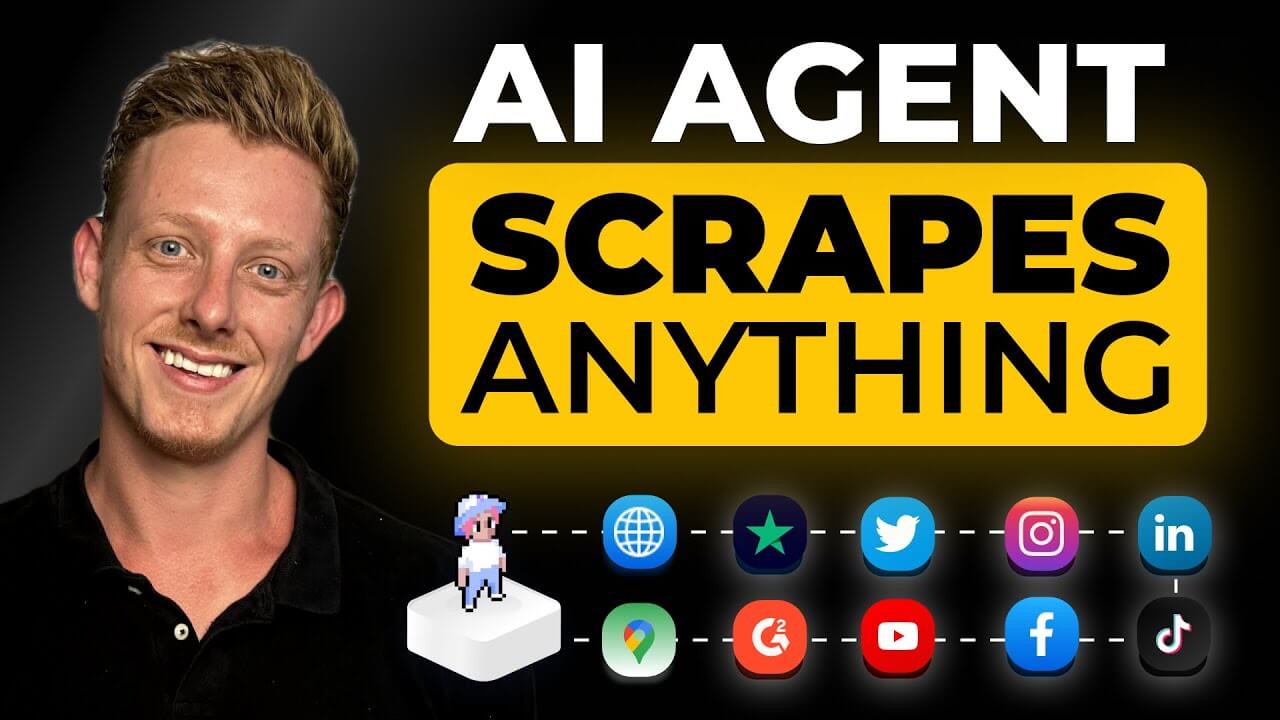To build an AI agent that scrapes data from websites, social media platforms, or other sources, you can follow these steps. The AI agent will use no-code platforms and automation tools to handle scraping, and you can interact with it via platforms like Slack. Here’s a detailed guide:
1. Choose Your Platforms
- Relevance AI: A no-code platform for building AI agents.
- Make.com (formerly Integromat): For setting up workflows to scrape data from sites or platforms that are harder to scrape directly.
- Phantom Buster / Apify / Dumpling AI: External tools that can be integrated for scraping specific data, especially from social media platforms like LinkedIn, X (formerly Twitter), Instagram, and more.
2. Set Up Relevance AI Agent
- Create the Agent: In Relevance AI, you’ll first create an agent. This agent will be responsible for managing and delegating tasks to sub-agents (for specific scraping jobs like scraping LinkedIn, X, etc.).
- Define Core Instructions: Set up the core instructions or “prompts” for the agent. These will tell the agent what kind of scraping tasks it needs to do (competitor analysis, lead scraping, etc.).
- Configure Tools: You’ll set up tools inside Relevance AI that handle scraping tasks, API calls, or managing other sub-agents.
3. Use No-Code Scraping Tools
- Phantom Buster: This is useful for scraping social media data (e.g., LinkedIn profiles, Instagram, X). You can automate tasks like extracting followers, posts, and engagement metrics.
- Apify or RapidAPI: These are other options if you need APIs for scraping data from websites or directories.
- Dumpling AI: Great for extracting structured data like YouTube video transcripts or Google search results.
4. Automate Workflows with Make.com
- Trigger the Agent: Use Make.com to automate the scraping workflows. For example, if your agent needs to scrape Twitter posts, you can trigger a Make.com workflow that:
- Grabs the required URLs or accounts to scrape.
- Uses Phantom Buster to scrape those accounts.
- Processes the data and sends it back to Relevance AI.
- Set up Data Handling: Once scraped data is gathered (like blog posts, social media mentions, reviews), format it for analysis. Use Make.com or Relevance AI’s built-in tools to clean, organize, and store the data.
5. Slack Integration for User Interaction
- Set Up a Slack Bot: You can interact with your agent using Slack by setting up a custom bot. When you send a message in a Slack channel (like “Scrape LinkedIn for competitors”), the bot triggers the agent in Relevance AI.
- Send Messages to Relevance AI: Your Slack bot sends the user’s request to Relevance AI, which will then delegate the scraping task to the correct sub-agent.
- Receive Reports via Slack: Once the scraping is complete, the AI agent sends back a detailed report to your Slack channel (or an alternative location like Google Docs or Sheets).
6. Sub-Agent Setup (Scraping Specific Platforms)
- Social Media Scraping: For platforms like LinkedIn, X, or YouTube:
- Use Phantom Buster or Apify tools that are integrated with Make.com to automate the process.
- Scrape profiles, posts, comments, and engagement data.
- Process this data with Relevance AI’s tools or directly send it to a Slack channel or Google Docs.
- Website Scraping: Use Relevance AI’s built-in web scraper or integrate it with Make.com and other scraping tools to handle more complex scraping tasks (like extracting blog posts, reviews, or even visual elements like screenshots of a homepage).
7. Generate Reports
- Clean and Organize Data: Once you have all the data, use AI models (like GPT) to generate structured reports. These reports can cover things like competitor analysis, review summaries, content gap analysis, etc.
- Store Data in Google Docs or Sheets: Send formatted reports to Google Docs, Sheets, or directly into a Slack channel for easy access.
8. Scale the Agent
- Add More Sub-Agents: You can create sub-agents for specific scraping tasks. For example, one agent for scraping social media data, another for scraping news, and yet another for gathering reviews or blogs.
- Expand Platforms: Use Apify, RapidAPI, or Dumpling AI to add more platforms, like Instagram, Facebook, or YouTube, to your scraping capabilities.
9. Run Regularly for Ongoing Tasks
- Schedule Scraping: You can schedule scraping tasks to run daily, weekly, or monthly, depending on your needs. For example, you could have the agent run competitor analysis reports every month.
10. Advanced Features
- Lead Scraping: You can set up the agent to scrape leads from social media posts (e.g., people commenting on competitors’ posts) and generate personalized outreach emails or messages.
- Visual Scraping: For tasks like extracting branding information, you can use visual scraping tools to take screenshots of competitors’ websites and analyze the visual elements.
Example Use Case: Competitor Analysis Agent
- Task: Scrape competitors’ LinkedIn, X, YouTube, and blogs.
- Slack Command: “Please do a competitor analysis on HubSpot and Pipedrive for the last month.”
- Agent Response: The agent scrapes all requested platforms, processes the data, and sends you back a detailed competitor analysis report via Slack.
Conclusion
Building an AI agent to scrape anything can be done with a combination of no-code platforms like Relevance AI and Make.com, combined with powerful tools like Phantom Buster, Apify, or Dumpling AI. This setup allows you to gather data quickly and efficiently, from websites, blogs, social media, and even visual elements like branding.
By integrating Slack for easy interaction, you can manage and request these tasks seamlessly.

